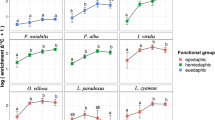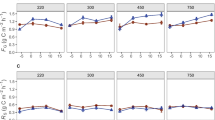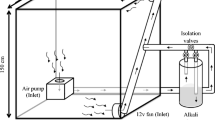Abstract
It has been demonstrated that plant roots can take up small amounts of low-molecular weight (LMW) compounds from the surrounding soil. Root uptake of LMW compounds have been investigated by applying isotopically labelled sugars or amino acids but not labelled organic matter. We tested whether wheat roots took up LMW compounds released from dual-labelled (13C and 15N) green manure by analysing for excess 13C in roots. To estimate the fraction of green manure C that potentially was available for root uptake, excess 13C and 15N in the primary decomposers was estimated by analysing soil dwelling Collembola that primarily feed on fungi or microfauna. The experimental setup consisted of soil microcosm with wheat and dual-labelled green manure additions. Plant growth, plant N and recoveries of 13C and 15N in soil, roots, shoots and Collembola were measured at 27, 56 and 84 days. We found a small (<1%) but significant uptake of green manure derived 13C in roots at the first but not the two last samplings. About 50% of green manure C was not recovered from the soil-plant system at 27 days and additional 8% was not recovered at 84 days. Up to 23% of C in collembolans derived from the green manure at 56 days (the 27 days sampling was lost). Using a linear mixing model we estimated that roots or root effluxes provided the main C source for collembolans (54−79%). We conclude that there is no solid support for claiming that roots assimilated green manure derived C due to very small or no recoveries of excess 13C in wheat roots. During the incubation the pool of green manure derived C available for root uptake decreased due to decomposition. However, the isotopic composition in Collembola indicated that there was a considerable fraction of green manure derived C in the decomposer system at 56 days thus supporting the premise that LMW compounds containing C from the green manure was released throughout the incubation.



Similar content being viewed by others
References
Albers D, Schaefer M, Scheu S (2006) Incorporation of plant carbon into the soil animal food web of an arable system. Ecology 87(1):235–245
Axelsen JA, Thorup-Kristensen K (2000) Collembola and mites in plots fertilised with different types of green manure. Pedobiologia 44:556–566
Bakonyi G (1998) Nitrogen turnover of Sinella coeca (Collembola: Entomobryidae). Eur J Entomol 95(3):321–326
Bardgett RD, Streeter TC, Bol R (2003) Soil microbes compete effectively with plants for organic-nitrogen inputs to temperate grasslands. Ecology 84(5):1277–1287
Boddy E, Hill P W, Farrar J, Jones DL (2007) Fast turnover of low molecular weight components of the dissolved organic carbon pool of temperate grassland field soils. Soil Biol Biochem 39(4):827–835
Briones MJI, Ineson P, Sleep D (1999) Use of δ13C to determine food selection in collembolan species. Soil Biol Biochem 31(6):937–940
Brown RA (1985) Effects of some root-grazing arthropods on the growth of sugar-beet. In: Fitter AH, Atkinson D, Read DJ, Usher MB (eds) Ecological interactions in soil: plants, microbes and animals. Blackwell Science Published, Oxford, pp 285–295
Cole L, Staddon PL, Sleep D, Bardgett RD (2004) Soil animals influence microbial abundance, but not plant-microbial competition for soil organic nitrogen. Funct Ecol 18(5):631–640
Coleman D, Fu S, Hendrix P, Crossley D Jr (2002) Soil foodwebs in agroecosystems: impacts of herbivory and tillage management. Eur J Soil Biol 38(1):21–28
Despland E, Noseworthy M (2006) How well do specialist feeders regulate nutrient intake? Evidence from a gregarious tree-feeding caterpillar. J Exp Biol 209(7):1301–1309
Evans RD (2001) Physiological mechanisms influencing plant nitrogen isotope composition. Trends Plant Sci 6(3):121–126
Evans RD, Bloom AJ, Sukrapanna SS, Ehleringer JR (1996) Nitrogen isotope composition of tomato (Lycopersicon esculentum Mill. cv. T-5) grown under ammonium or nitrate nutrition. Plant Cell Environ 19(11):1317–1323
Farquhar GD, Richards RA (1984) Isotopic composition of plant carbon correlates with water-use efficiency of wheat genotypes. Aus J Plant Physiol 11(6):539–552
Farrar J, Hawes M, Jones D, Lindow S (2003) How roots control the flux of carbon to the rhizosphere. Ecology 84(4):827–837
Filser J (2002) The role of Collembola in carbon and nitrogen cycling in soil. Pedobiologia 46(3–4):234–245
Fry B (2006) Stable Isotope Ecology. Springer, Berlin, p 308
Garrett CJ, Crossley DA Jr, Coleman DC, Hendrix PF, Kisselle KW, Potter RL (2001) Impact of the rhizosphere on soil microarthropods in agroecosystems on the Georgia piedmont. Appl Soil Ecol 16(2):141–148
Gorissen A, Kuikman PJ, Van Ginkel JH, Van de Beek H, Jansen AG (1996) ESPAS—an advanced phytotron for measuring carbon dynamics in a whole plant-soil system. Plant Soil 179(1):81–87
Hodge A, Robinson D, Griffiths BS, Fitter AH (1999) Why plants bother: root proliferation results in increased nitrogen capture from an organic patch when two grasses compete. Plant Cell Environ 22(7):811–820
Hodge A, Stewart J, Robinson D, Griffiths BS, Fitter AH (2000) Spatial and physical heterogeneity of N supply from soil does not influence N capture by two grass species. Funct Ecol 14(5):645–653
Hogberg P (1997) Tansley review No 95—N-15 natural abundance in soil-plant systems. New Phytol 137(2):179–203
Janzen HH, Schaalje GB (1992) Barley response to nitrogen and non-nutritional benefits of legume green manure. Plant Soil 142(1):19–30
Johnson JF, Allan DL, Vance CP, Weiblen G (1996) Root carbon dioxide fixation by phosphorus-deficient Lupinus albus—contribution to organic acid exudation by proteoid roots. Plant Physiol 112(1):19–30
Jones DL, Healey JR, Willett VB, Farrar JF, Hodge A (2005) Dissolved organic nitrogen uptake by plants—an important N uptake pathway? Soil Biol Biochem 37(3):413–423
Joosse ENG, Koelman T (1979) Evidence for the presence of aggregation pheromones in Onychiurus armatus (Collembola), a pest insect in sugar-beet. Entomol Exp Appl 26(2):197–201
Kuzyakov Y, Jones DL (2006) Glucose uptake by maize roots and its transformation in the rhizosphere. Soil Biol Biochem 38(5):851–860
Larsen T, Luxhøi J, Magid J, Jensen LS, Krogh PH (2007) Properties of anaerobically digested and composted municipal solid waste assessed by linking soil mesofauna dynamics and nitrogen modelling. Biol Fertil Soils DOI 10.1007/s00374-007-0178-x
Lipson D, Nasholm T (2001) The unexpected versatility of plants: organic nitrogen use and availability in terrestrial ecosystems. Oecologia 128(3):305–316
Lopes MS, Araus JL (2006) Nitrogen source and water regime effects on durum wheat photosynthesis and stable carbon and nitrogen isotope composition. Physiol Plantarum 126(3):435–445
Lopes MS, Nogues S, Araus JL (2004) Nitrogen source and water regime effects on barley photosynthesis and isotope signature. Funct Plant Biol 31(10):995–1003
Lussenhop J (1996) Collembola as mediators of microbial symbiont effects upon soybean. Soil Biol Biochem 28(3):363–369
Magid J, Luxhøi J, Lyshede OB (2004) Decomposition of plant residues at low temperatures separates turnover of nitrogen and energy rich tissue components in time. Plant Soil 258(1):351–365
Martens DA, Frankenberger WT (1994) Assimilation of exogenous 2′-14C-indole-3-acetic acid and 3′-14C-tryptophan exposed to the roots of three wheat varieties. Plant Soil 166(2):281–290
Mozafar A (1994) Enrichment of some B-vitamins in plants with application of organic fertilizers. Plant Soil 167:305–311
Nasholm T, Huss-Danell K, Hogberg P (2001) Uptake of glycine by field grown wheat. New Phytol 150(1):59–63
Ostle N, Briones MJI, Ineson P, Cole L, Staddon P, Sleep D (2007) Isotopic detection of recent photosynthate carbon flow into grassland rhizosphere fauna. Soil Biol Biochem 39(3):768–777
Owen AG, Jones DL (2001) Competition for amino acids between wheat roots and rhizosphere microorganisms and the role of amino acids in plant N acquisition. Soil Biol Biochem 33(4–5):651–657
Partsch S, Milcu A, Scheu S (2006) Decomposers (Lumbricidae, Collembola) affect plant performance in model grasslands of different diversity. Ecology 87(10):2548–2558
Pelz O, Abraham WR, Saurer M, Siegwolf R, Zeyer J (2005) Microbial assimilation of plant-derived carbon in soil traced by isotope analysis. Biol Fertil Soils 41(3):153–162
Phillips DL, Gregg JW (2003) Source partitioning using stable isotopes: coping with too many sources. Oecologia 136(2):261–269
Ruf A, Kuzyakov Y, Lopatovskaya O (2006) Carbon fluxes in soil food webs of increasing complexity revealed by 14C labelling and 13C natural abundance. Soil Biol Biochem 38(8):2390–2400
Ulber B (1983) Einfluss von Onychiurus fimatus Gisin (Collembola, Onychiuridae) and Folsomia fimetaria L. (Collembola, Isotomidae) auf Pythium ultimum Trow., einen erreger des Wurzelbrandes der Zuckerrübe. In: Lebrun P, André HM, De Medts A , Grégoire Wibo C, Wauthy G (eds) New trends in soil biology. Proceeding of VIII. International Coll. Soil Zool. Louvain-la-Neuve (Belgium), pp 261–268, August 30–September 2, 1982
Van Ginkel JH, Gorissen A (1998) In situ decomposition of grass roots as affected by elevated atmospheric carbon dioxide. Soil Sci Soc Am J 62(4):951–958
Weigelt A, Bol R, Bardgett RD (2005) Preferential uptake of soil nitrogen forms by grassland plant species. Oecologia 142(4):627–635
Yoneyama T, Omata T, Nakata S, Yazaki J (1991) Fractionation of nitrogen isotopes during the uptake and assimilation of ammonia by plants. Plant Cell Physiol 32(8):1211–1217
Acknowledgements
This study was part of the research project “Closing the Rural-Urban Nutrient Cycle (CRUCIAL)” supported by Danish Research Centre for Organic Farming, DARCOF. Marc Ventura was supported by a Marie Curie post-doctoral grant (MEIF-CT-2005-010554). We thank Ole Andersen from Sejet Planteforædling for supplying the wheat seeds.
Author information
Authors and Affiliations
Corresponding author
Additional information
Responsible Editor: A. C. Borstlap.
Rights and permissions
About this article
Cite this article
Larsen, T., Gorissen, A., Krogh, P.H. et al. Assimilation dynamics of soil carbon and nitrogen by wheat roots and Collembola. Plant Soil 295, 253–264 (2007). https://doi.org/10.1007/s11104-007-9280-y
Received:
Accepted:
Published:
Issue Date:
DOI: https://doi.org/10.1007/s11104-007-9280-y




